- Home
- William H. Keith
Symbionts Page 10
Symbionts Read online
Page 10
“So you’re coming along, Professor?” Dev asked Brenda Ortiz, who was serving as their guide.
“Do you think I’d miss an opportunity like this, Captain?” she replied. “I’ve been working for this for three years now, and I may never have a chance like this again.”
Originally an AI metalogician from the Universidad de Mexico on Earth, Professor Ortiz had first visited the Alyan system with the Imperial Expeditionary Force three years before as an expert on alternative logic. Since the IEF’s return to the Shichiju, however, she’d been attached to the newly founded Xenosophontology Department of Jefferson University on New America.
The outbreak of open civil war had stranded her on New America until the Confederation government decided to abandon that world. From what Dev had heard, Ortiz was completely apolitical, uninterested in taking sides in the worsening rebellion that was flaming across the Frontier. She’d reasoned, however, that the Imperials would be unlikely to allow anyone on New America access to the Alyans. If she wanted to continue her studies of them, she would have to do so through projects sponsored by the Confederation.
And as far as the Confederation was concerned, they couldn’t afford to lose her expertise. Not now, with Farstar at last about to bear fruit.
“Is this sim supposed to be set on ShraRish or Ghegnu-Rish?” Sinclair wondered aloud.
The fifth world of Alya B was GhegnuRish, the original DalRiss homeworld; the sixth planet of Alya A was ShraRish, a once-lifeless world altered some twenty thousand years before to support a DalRiss-engineered ecology.
“This is A-VI, General Sinclair,” Ortiz replied, looking around with something like a proprietorial pride in her eyes. “According to our most up-to-date information, the DalRiss are back on Ghegnu again, but not in large numbers. The tame Naga there is helping them rebuild the place, but I gather it’s still not much like what they think of as home.”
“Hell of a note,” Dev said. “Having to terraform your own homeworld. Or maybe ‘DalRissaform’ would be a better word.”
The others laughed.
DalRiss civilization on GhegnuRish had been destroyed long before by the Naga occupying that world’s crust. Dev had haunting memories of that silent, tortured landscape, of strangely grown buildings and less identifiable structures consumed and reworked by the alien Naga. By the time the Imperial Expeditionary Force had arrived, a second Xenophobe had nearly wiped the DalRiss out on their colony world of ShraRish as well. The IEF had used deep-penetrator nuclear weapons to destroy the Xenophobe manifestation on ShraRish, but on GhegnuRish, Dev had managed to make contact with the Naga, the first time such a thing had ever been tried.
“What we’re seeing here was programmed by the Imperial mission at Dojinko,” Ortiz continued as the group picked its way past a sponge-covered outcropping. Overhead, sulfur clouds bulked huge, violet-silver where they faced the sun, golden brown to red-black in their shadowed bellies. “I gather some of your intelligence people copied it from a research station and smuggled it out to New America. It’s about two years old.”
“Are we sure the data’s solid?” Sinclair wondered. “Some of this looks so strange. Like some Imperial intelligence officer’s nightmare.”
“It looks like I remember it, sir,” Dev told him. “Pretty much, anyway. I don’t remember seeing a lot of these plants when we were at ShraRish before, but from what I understand there’s a lot more variety to the life there than on most human worlds.” He nudged a writhing clump of purple vegetation with the toe of his boot. “That’s why there are so many different shapes and colors.”
“Deliberate variety,” Ortiz agreed. “The DalRiss genegineer everything, remember, including themselves. Natural evolution is faster, too. The ecosystem is driven by very high levels of ambient radiation.”
That much was obvious simply from the activity displayed by the ground cover. The Alyan suns, circling one another at a mean distance of nine hundred astronomical units, were a type A5 and a type A7, respectively nineteen and thirteen times brighter than Earth’s sun. Energy spendthrifts, such stars squandered their hydrogen capital in a fraction of the time taken by older, cooler suns like Sol. Where life on Earth had taken the better part of four billion years to evolve from self-replicating molecules to intelligence, the same process had taken a few hundred million years on Alya B-V, in a high-energy environment where all of the processes that made life what it was, from biochemical reactions to metabolisms to random mutations, seemed speeded up from a human perspective.
“All chemical processes are faster?” Katya asked. “I wonder, do the DalRiss think faster than we do?”
“Almost certainly,” Ortiz replied. “In our discussions with them, we get the definite impression that they spend a lot of time—from their points of view, anyway—just standing and waiting for our replies. Fortunately, they seem to possess more patience than do most humans. Otherwise we might never have been able to talk with them at all.”
Drops of rain began falling, though Dev felt nothing in the simulation. That was just as well, he thought, for rain on the DalRiss worlds contained high concentrations of sulfuric acid. “This is why we’d need suits in the actual environment,” Ortiz said cheerfully. “It’s actually possible to walk around with no special gear at all save a breathing mask, for short times, at least, but this rain could burn you.”
“The ultraviolet’s pretty harsh for unprotected skin,” Dev added. “That would burn you too.”
“The predominant gas in the mix is nitrogen, as I recall,” Sinclair said. “But less than nine percent oxygen.”
“Depending on who you talk to,” Ortiz said. “For a while, the Imperials were confusing the issue with data that suggested the DalRiss worlds were just like Venus, except for low surface pressure. Impossible to visit without very special gear.”
“They wanted to discourage unofficial exploration,” Katya said. “And casual visitors.”
“Are those buildings?” Dev asked, pointing at some low, slick-surfaced shapes of various dark colors a hundred meters off. Actually, they looked more like trees than artificial structures… though Alyan trees little resembled their Earth-grown namesakes. They were squat and rounded, growing out of the ground rather than sitting on it, more similar to large gourds or oddly carved lumps of sponge than anything else.
“Dwellings, yes,” Ortiz replied. “Of course, while they’re normally sessile, they can move, and they’re more attached to their owners than to the landscape. We’ve found that DalRiss family groups tend to shift and change around a lot. When an individual leaves the current grouping, his part of the group’s communal dwelling goes with him.”
The DalRiss had followed a cultural and technological evolution quite different from that pursued by Man, developing the biological sciences almost to the exclusion of the others. They grew homes and workplaces and entire cities rather than building them, using genetic engineering to develop a bewildering array of organisms, from manufactured viruses to vast organisms of obscure purpose hundreds of kilometers across. For the DalRiss, chemistry had been a product of biological research, rather than the other way around. Mining, refining, and smelting were relatively new processes carried out by organisms that extracted elements and compounds from rock or the sea, and the products were generally incorporated into new life-forms, rather than being assembled as the inorganic components of lifeless structures.
Even the physical appearance of the DalRiss could vary tremendously, for individuals seemed to have less interest in outward form and appearance than did humans. DalRiss were composite creatures, a relatively small and physically weak Riss, or master, symbiotically riding the nervous system of a gene-tailored Dal that provided it with legs and strength. Most common were massive creatures like spiny, six-legged starfish that bore their riders in a mouthlike orifice atop their bodies, but Dev had seen organic combat vehicles, living warstriders, mounting weaponry based on explosives and complex acids. As a human might plug himself into an AI-directed veh
icle or other piece of equipment, a Riss could plug itself into its Dal, into its dwelling, or into some other creature designed to eat or manufacture things or procreate. Even their spacecraft were enormous, deliberately bred organisms that used hydrogen combustion to make orbit and an as yet unidentified means of bending space to cross from star system to star system.
Raindrops splattered about them, then dwindled away. The sky was as active as the vegetation, with clouds gathering, then breaking up in surreal patterns of silver, violet, and brown.
The group was walking toward the crest of a low ridge nearby. As they started climbing, movement caught Dev’s eye. “There’s one,” Sinclair said, pointing. “A DalRiss, I mean. What’s it doing?”
The DalRiss was standing on the crest of the ridge about twenty meters away, a bristling of spines and tentacles growing erect atop its ponderous, six-limbed organic transport. Its head—at least, Dev thought of that ragged crescent shape with the odd, eyeless protuberances to either side as a head—was cocked back at an angle, and the tentacles were telescoping in and out with a flickering, bewildering rapidity that had no obvious purpose. The leathery swelling at the back of the crescent, which Dev had been told housed the creature’s braincase, was glistening wet, perhaps from some internal secretion, though it could have been the rain. A trilling sound, wavering at the very edge of human hearing, fluted in and out of Dev’s perception.
To Dev, it looked as though the thing was singing in the rain.
“Unknown,” Ortiz said, answering Sinclair’s question after a brief pause. “Art form? Religious observance? Singing? Eliminating body wastes?”
“They see with active sonar,” Dev said. The crescent-shaped “head,” he’d been told, was a fluid-filled organ used to focus sound waves, while the widely spaced stalks to either side picked up the echoed returns. “Maybe it’s looking for something.”
“A lost compatch,” Katya suggested. “I’m always losing mine.”
“In the sky?” Ortiz asked. She sighed. “Three years of research and we still know almost nothing about them.”
“You know, I thought we had their language down pretty well,” Sinclair said. “If it wasn’t for their cornels, we’d never have been able to communicate with the Naga. They must understand interspecies communication in ways we can’t even guess at yet.”
“Oh, we can talk with them, if that’s what you mean, thanks to their cornels, and thanks to that patience I mentioned. We can share impressions and some sensory data and, with a computer’s help, we can translate the sounds they make as articulate speech. The cornels go a step further and actually translate certain nerve impulses into recognizable analogues, allowing, well, not telepathy, exactly, but a way of sharing feelings, emotions, even some memories, though we still don’t know how they do that.
“But the cultural and physical framework behind their language is different from ours, obviously. A lot different. We ask a question and we get what sounds like a rational answer. The only problem is, we often don’t know if either the question or the answer means the same to the DalRiss as it does to us.”
“Well, have you asked about what it’s doing now?” Katya wanted to know. “What’s its ‘rational answer’?”
“It depends,” Ortiz said, smiling. “Sometimes they say communing, though they won’t say with what. Our translation programs also render it as easing, or sometimes as draining. You see, their spoken language is quite complex, with multiple layers of meaning. Um, imagine having three mouths, and being able to carry on a conversation with one voice, while adding a running commentary with another and providing thesaurus elaborations or dictionary definitions with the third, all at the same time.”
“They have three mouths?” Sinclair asked.
“No. They use what we call a mouth for eating, not for speaking. Their speech is generated by a series of bladders inside their sonic organ, that big crescent on top of the body.”
“Okay, so what does this communing you mentioned mean?” Dev asked. “I don’t care how complex the word is, it’s got to have meaning, right? What do the experts say?”
Ortiz shook her head. “There are no experts in this business, Captain. Only guessers, and sometimes one guess is as good as another, especially when the, the elaborations by the different voices are contradictory. Or seem contradictory to us.
“Look, the modern approach to human psychology is, what? Three or four centuries old. If you count the half-superstitious speculation that passed for a science before that—and there were some important insights to come out of precephlink research, of course—then it’s a lot older than that. Yet we still have trouble understanding why people do what they do, why they think the way they do, today. We’ve been studying these people for three years, now. How much progress do you suppose we could make in that short a time, given that we knew almost nothing about their ecology, their evolution, their moral and ethical standards, their motivations to begin with. Hell, it took us awhile just to figure out that what we thought of as a DalRiss was really made up of two more or less separate organisms. We’re not going to really understand these folks for a long, long time to come!”
The solitary DalRiss was joined by a second being apparently identical to the first, its six-limbed Dal moving with a peculiar grace for such a large creature. A third arrived moments later, joining the first two in a rapid-fire flickering of their tentacles and a piping cacophony of peculiar, fluting sounds. Dev could detect no difference among them as individuals, and even their gestures appeared eerily coordinated. Their movements, lightning quick, possessed a fluidity that belied the ponderous mass of their mounts.
“Are they aware of us?” Dev asked.
“The sim’s been set to show them without interaction,” Ortiz replied. “So they’ll act as though we weren’t here. But we can reset if you want to question one. This sim has a fairly extensive data base. Their replies will be pretty close to what the real ones might say.”
“I don’t think that’ll be necessary,” Katya said.
“Yeah,” Dev added. “I’m not sure at this point if I’d even know what questions to ask.”
“The fact that they’re blind must make their perception of the world quite different from ours,” Sinclair said.
“They’re not blind,” Ortiz said. “They don’t have eyes, but they’re not blind. They use sonar, like bats or dolphins, though it seems to provide them with a genuine image of some kind, rather than just an echo. They have other imaging senses, too, apparently overlapping their sonar. They can sense motion, for instance… and, at least according to them, they can sense something they call ri, which they equate with some kind of life force. In fact, they visualize their surroundings more in terms of a three-dimensional sea of life through which they move than as empty space that happens to be occupied here and there by other creatures. They, well, they do perceive the world quite differently from the way we do.”
“Like the Naga,” Dev suggested.
Ortiz laughed. “Maybe not that differently. At least these folks don’t see the universe inside out! But a DalRiss can scan you and tell what you ate for lunch, see what you’re hiding inside your closed fist, and just by ‘looking’ at you, can trace your cephlink circuits from your palm implant to the feeds running up your arm to the sockets, cephware, and internal RAM nodes hidden inside your skull. They have trouble discerning human facial features and they don’t know what color is, but they have senses that we don’t. They see nonliving things—rock, for instance—as a kind of empty void with a definite shape. That difference in the way they perceive things makes aspects of their logic quite different from ours.”
“How?” Dev asked.
“Um, well, one of their nonhuman senses is a little like the lateral line in fish. It detects extremely minute variations in air pressure and seems to help them sense the positions of objects around them. See those three on the ridge? Do you see how their heads are all held at the same angle, and how their limb movements are coordin
ated? It’s almost as though they’re performing a dance, but with a very precise awareness of each others’ attitudes and gestures.”
“Group mind?” Sinclair asked.
“We wondered about that for a time, but no. They’re still individuals. But they do have much more of a sense of, call it community, than we do. With us, there’s a certain amount of social pressure to blend in, to be just like everybody else, right? But that only extends so far. There’ve always been people who disliked the herd mentality, who struck off and did things on their own and in their own way. We think, think, mind you, that the DalRiss find it easier to come to a group consensus because they’re so attuned to one another’s attitudes—both physical and mental. There’s almost certainly less of a sense of self, compared with more of a sense of the group as a whole. Not a group mind, General Sinclair, but a feeling that the needs of the group come before the needs of the individual.”
Dev felt an inner stirring of worry, almost of fear. “You know, Professor, what you’ve just described is a large part of the difference between Japanese culture and most Frontier societies. The Japanese feel they have a social obligation that should be placed ahead of the needs of any one person.”
“Captain, I think even the Japanese would be uncomfortable with what the DalRiss consider to be social obligation.”
“Arranged marriages,” Katya said, grinning.
“That’s one. Mating among the DalRiss is done strictly according to genetic considerations, and mates are frequently changed to ensure the widest possible distribution of certain characteristics within the gene pool. Genetic defectives are killed at birth, that’s another. And the old, I gather, are eaten, with great ceremony.”
“Arranged marriages, infanticide, and cannibalism have all been practiced by various human cultures, Professor,” Sinclair pointed out. “And the acceptance of those practices by the community reflects what the group at large believes in.”

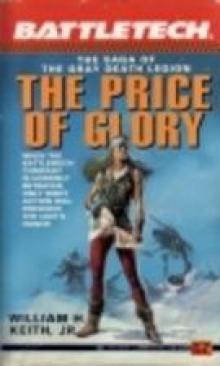 The Price of Glory
The Price of Glory Symbionts
Symbionts Rebellion
Rebellion Warstrider 04 - Symbionts
Warstrider 04 - Symbionts Netlink
Netlink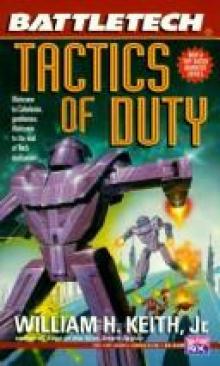 Tactics of Duty
Tactics of Duty Warstrider 06 - Battlemind
Warstrider 06 - Battlemind Mercenary's Star
Mercenary's Star Battlemind
Battlemind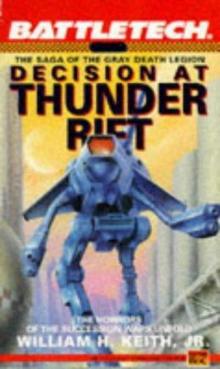 Decision at Thunder Rift
Decision at Thunder Rift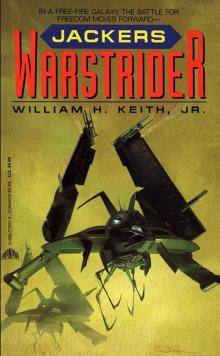 Jackers
Jackers Android: Free Fall
Android: Free Fall Warstrider 01 - Warstrider
Warstrider 01 - Warstrider Warstrider 05 - Netlink
Warstrider 05 - Netlink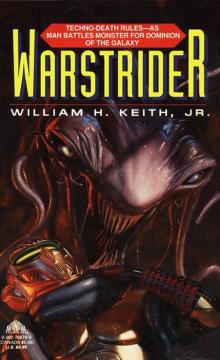 Warstrider
Warstrider